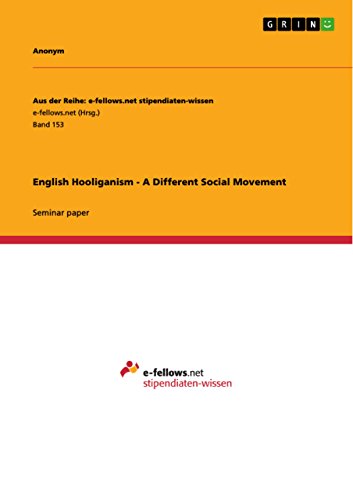English Hooliganism - A Different Social Movement - Softcover

"synopsis" may belong to another edition of this title.
- PublisherGRIN Verlag
- Publication date2011
- ISBN 10 364097431X
- ISBN 13 9783640974313
- BindingPaperback
- Number of pages28
Buy New
Learn more about this copy
Shipping:
US$ 24.74
From Germany to U.S.A.
Top Search Results from the AbeBooks Marketplace
English Hooliganism - A Different Social Movement
Book Description Taschenbuch. Condition: Neu. This item is printed on demand - it takes 3-4 days longer - Neuware -Seminar paper from the year 2009 in the subject Sociology - Political Sociology, Majorities, Minorities, grade: 1,33, Jacobs University Bremen gGmbH, language: English, abstract: More than 37 million spectators attended football games in 2007-08 while 3,842 people were arrested for disorder connected to matches according to the UK Home Office. Of those arrests, 373 were for violent crimes - an increase of 33 over the previous season. On the other hand, 67% of matches were problem-free and did not result in any arrest. Instead, 60% of football-related arrests took place outside or away from the football stadia (Home Office, 2008). These statistics show that football violence is at least remarkable enough to draw attention of government departments and statisticians. In the past decades, numerous scholars have tried to analyse the roots and dynamics of this violent fan behaviour (Dunning, 2000) that has been labelled 'Hooliganism'. The name-giving implies that football-related violence is considered as more than just some weekly disturbances. It is regarded as a social phenomenon which needs to be observed, investigated, and defined which can eventually lead to an understanding of and response to this behaviour. In our paper we will expose to what extent this phenomenon can be classified as a social movement. Before, we will look at the rise and growth of Hooliganism exemplifying it with some extreme occurrences. We are going to describe Hooligan behaviour and the people who engage in it trying to pin point typical characteristics and motivations of Hooligans. Doing that we want to justify that Hooliganism can be understood as a social movement which will allow us to apply different social movement models on Hooliganism. In order to arrive at the rationale of Hooliganism a descriptive definition is necessary which will give the further analyses and interpretation a basic framework. With several similar definitions of Hooliganism to choose from, the one meaning that we are going to use as a point of departure terms Hooliganism as 'competitive violence of socially organized fan groups in football, principally directed against opposing fan groups' (Spaaij, 2006, p. 11). 28 pp. Englisch. Seller Inventory # 9783640974313
English Hooliganism - A Different Social Movement
Book Description Taschenbuch. Condition: Neu. Druck auf Anfrage Neuware - Printed after ordering - Seminar paper from the year 2009 in the subject Sociology - Political Sociology, Majorities, Minorities, grade: 1,33, Jacobs University Bremen gGmbH, language: English, abstract: More than 37 million spectators attended football games in 2007-08 while 3,842 people were arrested for disorder connected to matches according to the UK Home Office. Of those arrests, 373 were for violent crimes - an increase of 33 over the previous season. On the other hand, 67% of matches were problem-free and did not result in any arrest. Instead, 60% of football-related arrests took place outside or away from the football stadia (Home Office, 2008). These statistics show that football violence is at least remarkable enough to draw attention of government departments and statisticians. In the past decades, numerous scholars have tried to analyse the roots and dynamics of this violent fan behaviour (Dunning, 2000) that has been labelled 'Hooliganism'. The name-giving implies that football-related violence is considered as more than just some weekly disturbances. It is regarded as a social phenomenon which needs to be observed, investigated, and defined which can eventually lead to an understanding of and response to this behaviour. In our paper we will expose to what extent this phenomenon can be classified as a social movement. Before, we will look at the rise and growth of Hooliganism exemplifying it with some extreme occurrences. We are going to describe Hooligan behaviour and the people who engage in it trying to pin point typical characteristics and motivations of Hooligans. Doing that we want to justify that Hooliganism can be understood as a social movement which will allow us to apply different social movement models on Hooliganism. In order to arrive at the rationale of Hooliganism a descriptive definition is necessary which will give the further analyses and interpretation a basic framework. With several similar definitions of Hooliganism to choose from, the one meaning that we are going to use as a point of departure terms Hooliganism as 'competitive violence of socially organized fan groups in football, principally directed against opposing fan groups' (Spaaij, 2006, p. 11). Seller Inventory # 9783640974313

